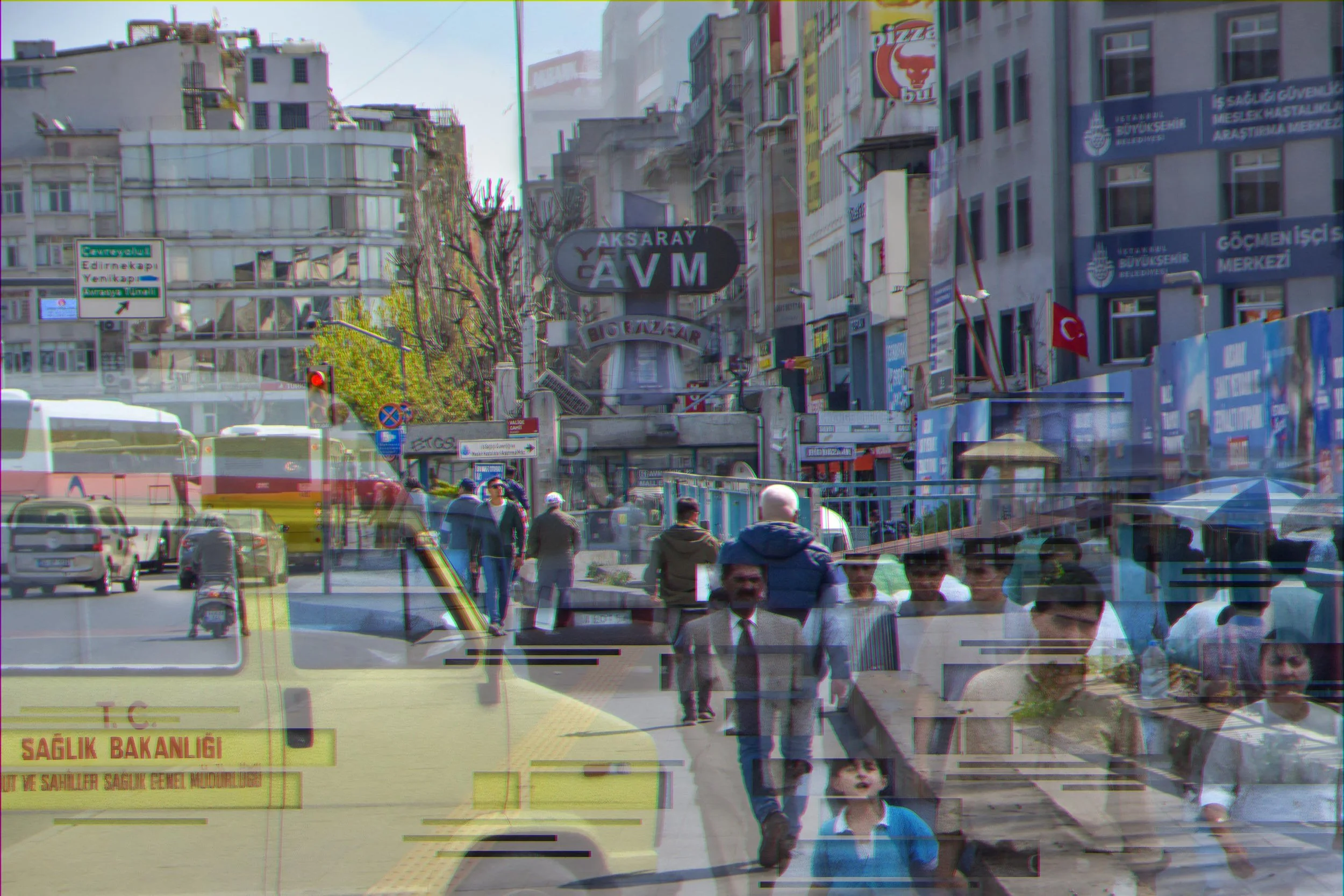10 Questions with Yanlin Song
Yanlin Song is a multidisciplinary illustrator based in Shanghai. She began her formal painting training in 2008, immersing herself in Impressionist works during this period. Her studies in architecture and art history in university further expanded her aesthetic sensibility and artistic vision. From 2017 to 2021, she worked as a brand designer while self-studying illustration. In 2022, she left her stable job to pursue independent creative work, choosing illustration as her medium to explore the relationship between herself and the external world.
Her artwork was shortlisted for the 10th Hiii Illustration International Competition in 2023 and won the iJUNGLE Illustration Awards 2023 Self-Promotion Merit Award. In 2024, her pieces were exhibited at the Tokyo Metropolitan Art Museum.
Yanlin Song - Portrait
ARTIST STATEMENT
Lin believes that human beings are part of nature and should accept the inevitable withering and death as gracefully as plants do. 2021 and 2024 experiences of major depression and anxiety prompted her to pay attention to human mental health and subconscious fears, and the torment of her illness compelled her to engage in in-depth self-reflection; she often uses human beings and nature as the starting point in her creations, exploring the blurring of the boundary between dreams and reality; animals, plants, and dreams have become an integral part of her works. "I always dream of strange scenes that I can't see in reality, and they are full of some kind of special inspiration, which I will record and create immediately after waking up from the dream."
After 24 years of recovering from anxiety, Lin began to use plants with female gender symbols in her paintings as a way of provoking reflection on the unseen feminine, encouraging women to explore their inner strength, accept all wounds and imperfections, and cultivate a warm and resilient inner being; those complex, aggressive tenderness and fragility, resilience and pain, are all true expressions of female strength; her work Inward Growth is the embodiment of this philosophy.
Flower Season, Digital Art, 30x40 cm, 2024 © Yanlin Song
INTERVIEW
First of all, can you tell us about your journey from architecture and brand design to illustration? What sparked the shift?
Architecture is the imagination and composition of space—macro in scale and vast in scope, encompassing all forms of art. Though seemingly complex, the root of all design begins with basic geometric forms. During this process, I also studied graphic design, photography, and furniture and lighting design.
Graphic art, on the other hand, is the imagination and composition of specific shapes, focusing on a microscopic perspective. Compared to architecture, it is a more abstract visual language, often used in branding and illustration, allowing me to fully utilize my passion for painting techniques. This led me to pursue branding design while simultaneously beginning my journey in illustration.
Design solves problems, and architecture represents a way of life—yet neither could fully satisfy my need for free expression. I enjoy design, but I love painting and creative expression even more. Once my studies and experience could support my creative vision, I wanted to dedicate more time to artistic work. So, I left my job and officially began my illustration career in 2022. Nevertheless, my architectural background continues to influence my way of life to this day.
Inward growth, Digital Art, 40x50 cm, 2024 © Yanlin Song
How do your studies and training influence your current work?
My earliest memories of learning to paint are largely tied to the Impressionists—they were my first teachers of colour. As is well known, Impressionism is renowned for capturing natural light and shadow. During my foundational studies in colour, I copied and analyzed numerous works by masters like Claude Monet, Camille Pissarro, and post-Impressionist Vincent van Gogh.
I would often paint in the studio from 7 AM until past 10 PM, an immersion that profoundly shaped my sensitivity to colour. Fortunately, even at that early stage, my art instructor incorporated basic creative shape exercises into our curriculum. This dual focus—on both chromatic perception and formal abstraction—continues to influence my work today, manifesting in my preference for incorporating geometric elements and particular colour harmonies within compositions.
Your work often blurs the line between dreams and reality. What role do dreams play in your creative process?
Dreams play a vital role in my creative work—some of my compositions are near-perfect recreations of dreamscapes. Take *Dreamland-Dragon* for instance: this piece directly translates a wondrous dream where I saw a winding road rising from the sea level. Standing on the ground, I witnessed a magnificent dragon soaring from the ocean, hovering mid-air to gaze at me as if trying to communicate. I strove to capture that surreal mysticism from the dream.
Yet not all are pleasant visions—some terrifying nightmares, often rooted in childhood memories, feel equally real. In my work Inward Growth, I employed spinning and static tops with translucent colours to express the blurred boundary between dreams and reality. To me, the ability to dream is a gift that allows my art to navigate freely between the dream world and waking life.
Dreamland Dragon, Digital Art, 30x40 cm, 2023 © Yanlin Song
How do you usually begin a new piece? Do you start with a dream, a feeling, or an image in your mind?
The beginning of creation often stems from a unique feeling or a wondrous dream. I record interesting experiences or dreams and refine the imagery in my mind—a process that requires time and contemplation. When the picture in my mind becomes clear enough, I quickly sketch it out. I often experiment with multiple drafts until the composition and elements can faithfully recreate the scene in my imagination. Dreams also bring me emotional experiences, and these feelings determine the colour palette of a piece.
Nature seems to be a strong theme in your illustrations. What draws you to this subject again and again?
In the presence of nature, humanity's attempts to protect or destroy it reveal our hubris—a single tree often outlives generations. We need nature profoundly, yet nature thrives without us. Within its embrace lies an ancient serenity.
In my home, I nurture many plants. Each morning, my first ritual is tending to them. Through their quiet existence, I witness an indomitable vitality—they follow nature's rhythms with grace, embracing both their flourishing and inevitable decay. Their transient beauty, so exquisite in its impermanence, has become a recurring motif in my work. These botanical forms are my homage to the enduring poetry of life itself.
Jungle Black Rabbit, Digital Art, 30x40 cm, 2022 © Yanlin Song
Merry Christmas, Digital Art, 30x40 cm, 2022 © Yanlin Song
You've spoken openly about your experiences with depression and anxiety. How has your mental health journey shaped your art?
Coexisting with depression and anxiety became a journey of profound self-discovery. The fears I'd consciously buried under practical concerns for years surfaced mercilessly during my illness—draining my vitality until only pain and terror remained. With severe PTSD as my constant companion, I existed in perpetual struggle, oscillating between longing for death and clinging fiercely to life.
This crucible led me to psychology and deepened my commitment to mental health advocacy. Now, having largely healed myself, I feel an electric vitality within—a force that also drew me to women's narratives. These transformative experiences birthed my artistic language: vibrant botanical elements now bloom across my canvases as symbols of resilience. This is how Inward Growth took root—a visual manifesto of survival and self-renewal.
In your recent works, you've used plants with feminine symbols to explore inner strength. What inspired this connection?
In the artwork Inward Growth, I use the imagery of a phalaenopsis orchid and a young girl to explore themes of feminine strength and self-acceptance. The orchid serves as a symbol of femininity, while the girl's self-embracing posture conveys the importance of self-love and inner resilience. The spinning top element in the composition represents the blurred boundary between dreams and reality, mirroring the journey of finding balance and awakening amidst anxiety and depression.
I'm deeply moved that this piece has resonated with so many viewers. It invites people to grow inward—cultivating a heart that is both tender and strong, and to face one's true self with courage.
Twist, Digital Art, 40x50 cm, 2024 © Yanlin Song
You've received international recognition. How have these experiences impacted your creative confidence or direction?
In my early creative explorations, I deliberately incorporated surrealist elements to experiment with visual expression.The recognition these works received undoubtedly reinforced my artistic convictions—yet I refuse to let any international acclaim confine my creative direction. True creation should always emerge as an organic, inward-to-outward impulse.
What's something you hope people feel or reflect on when they look at your illustrations?
I hope my works radiate a quiet, nurturing vitality—one that kindles self-love in those who encounter them.
Lastly, what are you working on now? And how do you see your work evolve in the future?
My current Flower Season series emerges from an ethereal dreamscape, where botanical motifs will unfold with greater abundance. Moving forward, while continuing my illustrative work, I'll embark on a new studio venture—weaving childhood recollections with the liminal space where dreams and reality converge. For this series, I'm returning to canvas, employing a visual grammar of theatrical staging and scattered perspective. This exploration promises to become a vital artery in my artistic body of work.
Artist’s Talk
Al-Tiba9 Interviews is a promotional platform for artists to articulate their vision and engage them with our diverse readership through a published art dialogue. The artists are interviewed by Mohamed Benhadj, the founder & curator of Al-Tiba9, to highlight their artistic careers and introduce them to the international contemporary art scene across our vast network of museums, galleries, art professionals, art dealers, collectors, and art lovers across the globe.





















